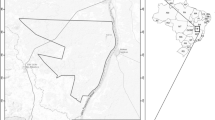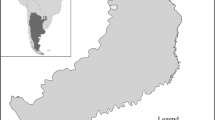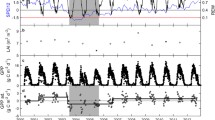Abstract
We estimated canopy structure and transmitted radiation using hemispherical photography in four monitoring years (2008–2010, 2016) following the 2008 huge ice storm in a subtropical forest in south China, so as to assess changes in canopy biophysical parameters during forest recovery from natural disturbance. Significant decrease in canopy openness (CO), transmitted direct radiation (TransDir), and transmitted diffuse radiation (TransDif), as well as significant increase in leaf area index (LAI), were found in the disturbed forest stand in the subsequent years following the ice storm, indicating rapid canopy recovery. In contrast, these biophysical parameters of the undisturbed forest stand were quite stable during the monitoring years. The strength of relationships between CO and other canopy biophysical parameters decreased in the disturbed stand along the monitoring years. The disturbed stand had common slopes for the CO-TransDir and CO-TransDif models in the first two monitoring years, but different slopes for the CO-LAI model between the first and the subsequent monitoring years, while the undisturbed stand had common slopes for all the regression models in the first three monitoring years following the huge ice storm. These results showed that stronger correlations of LAI or TransDir with CO were characteristic of less complex canopies, such as those damaged by disturbance; the sensitivity of transmitted radiation in response to CO decreased with canopy recovery. Our findings demonstrated that forests with different canopy structure varied in biophysical parameters, which can be quantified by hemispherical photography.








Similar content being viewed by others
References
Arii, K., & Lechowicz, M. J. (2007). Changes in understory light regime in a beech-maple forest after a severe ice storm. Canadian Journal of Forest Research-Revue Canadienne De Recherche Forestiere, 37, 1770–1776.
Beauder, M., & Messier, C. (2002). Variation in canopy openness and light transmission following selection cutting in northern hardwood stands: an assessment based on hemispherical photographs. Agricultural and Forest Meteorology, 110, 217–228.
Blennow, K. (1995). Sky view factors from high-resolution scanned fish-eye lens photographic negatives. Jounal of Atmospheric and Oceanic Technology, 12, 1357–1362.
Broadbent, E. N., Zarin, D. J., Asner, G. P., Pena-Claros, M., Cooper, A., & Littell, R. (2006). Recovery of forest structure and spectral properties after selective logging in lowland Bolivia. Ecological Applications, 16, 1148–1163.
Bucchignani, E., Zollo, A. L., Cattaneo, L., Montesarchio, M., & Mercogliano, P. (2017). Extreme weather events over China: assessment of COSMO-CLM simulations and future scenarios. International Journal of Climatology, 37, 1578–1594.
Calderon-Aguilera, L. E., Rivera-Monroy, V. H., Porter-Bolland, L., Martínez-Yrízar, A., Ladah, L. B., Martínez-Ramos, M., Alcocer, J., Santiago-Pérez, A. L., Hernandez-Arana, H. A., Reyes-Gómez, V. M., Pérez-Salicrup, D. R., Díaz-Nuñez, V., Sosa-Ramírez, J., Herrera-Silveira, J., & Búrquez, A. (2012). An assessment of natural and human disturbance effects on Mexican ecosystems: current trends and research gaps. Biodiversity and Conservation, 21, 589–617.
Covey, K. R., Barrett, A. L., & Ashton, M. S. (2015). Ice storms as a successional pathway for Fagus grandifolia advancement in Quercus rubra dominated forests of southern New England. Canadian Journal of Forest Research, 45, 1628–1635.
Curtis, S., Fair, A., Wistow, J., Val, D. V., & Oven, K. (2017). Impact of extreme weather events and climate change for health and social care systems. Environment Health, 16, 23–32.
Darwin, A. T., Ladd, D., Galdins, R., Contreras, T. A., & Fahrig, L. (2004). Response of forest understory vegetation to a major ice storm. The Journal of the Torrey Botanical Society, 131, 45–52.
Fayle, T. M., Chung, A. Y. C., Dumbrell, A. J., Eggleton, P., & Foster, W. A. (2009). The effect of rain forest canopy architecture on the distribution of epiphytic ferns (Asplenium spp.) in Sabah, Malaysia. Biotropica, 41, 676–681.
Frazer, G.W., Canham, C.D., Lertzman, K.P. (1999). Gap Light Analyzer (GLA), Version 2.0: imaging software to extract canopy structure and gap light transmission indices from true-colour fisheye photographs, users manual and program documentation. Simon Fraser University, Burnaby, British Columbia, and the Institute of Ecosystem Studies, Millbrook, New York.
Frazer, G. W., Fournier, R. A., Trofymow, J. A., & Hall, R. J. (2001). A comparison of digital and film fisheye photography for analysis of forest canopy structure and gap light transmission. Agricultural and Forest Meteorology, 109, 249–263.
Frolking, S., Palace, M. W., Clark, D. B., Chambers, J. Q., Shugart, H. H., & Hurtt, G. C. (2009). Forest disturbance and recovery: a general review in the context of spaceborne remote sensing of impacts on aboveground biomass and canopy structure. Journal of Geophysical Research – Biogeosciences, 114, G00E02.
Glatthorn, J., Pichler, V., Hauck, M., & Leuschner, C. (2017). Effects of forest management on stand leaf area: comparing beech production and primeval forests in Slovakia. Forest Ecology and Management, 389, 76–85.
Gotsch, S. G., Nadkarni, N., & Amici, A. (2016). The functional roles of epiphytes and arboreal soils in tropical montane cloud forests. Journal of Tropical Ecology, 32, 455–468.
Holdaway, R. J., Allen, R. B., Clinton, P. W., Davis, M. R., & Coomes, D. A. (2008). Intraspecific changes in forest canopy allometries during self-thinning. Functional Ecology, 22, 460–469.
Hopkin, A., Williams, T., Sajan, R., Pedlar, J., & Nielsen, C. (2003). Ice storm damage to eastern Ontario forests: 1998-2001. Forestry Chronicle, 79, 47–53.
Hossain, M. N., & Paul, P. (2019). Impacts of climatic variability on agriculture and options for adaptation in the Surma River basin, Bangladesh. Environmental Monitoring and Assessment, 191, 111.
Jonckheere, I., Fleck, S., Nackaerts, K., Muys, B., Coppin, P., Weiss, M., & Baret, F. (2004). Review of methods for in situ leaf area index determination: Part I. Theories, sensors and hemispherical photography. Agricultural and Forest Meteorology, 121, 19–35.
Jonckheere, I., Nackaerts, K., Muys, B., & Coppin, P. (2005). Assessment of automatic gap fraction estimation of forests from digital hemispherical photography. Agricultural and Forest Meteorology, 132, 96–114.
Lafon, C. W. (2004). Ice-storm disturbance and long-term forest dynamics in the Adirondack Mountains. Journal of Vegetation Science, 15, 267–276.
Lhotka, J. M., & Loewenstein, E. F. (2006). Indirect measures for characterizing light along a gradient of mixed-hardwood riparian forest canopy structures. Forest Ecology and Management, 226, 310–318.
Matiu, M., Bothmann, L., Steinbrecher, R., & Menzel, A. (2017). Monitoring succession after a non-cleared windthrow in a Norway spruce mountain forest using webcam, satellite vegetation indices and turbulent CO2 exchange. Agricultural and Forest Meteorology, 244, 72–81.
Nijland, W., Nielsen, S. E., Coops, N. C., Wulder, M. A., & Stenhouse, G. B. (2014). Fine-spatial scale predictions of understory species using climate- and LiDAR-derived terrain and canopy metrics. Journal of Applied Remote Sensing, 8, 083572.
Ogawa, K. (2018). Mathematical consideration of the age-related decline in leaf biomass in forest stands under the self-thinning law. Ecological Modelling, 372, 64–69.
Ou, Y. D., Su, Z. Y., Ke, X. D., & Li, Z. K. (2012). Vascular ground flora in relation to topography, canopy structure and gap light regimes in a subtropical broadleaved forest (South China). Polish Journal of Ecology, 60, 463–478.
Reichstein, M., Bahn, M., Ciais, P., Frank, D., Mahecha, M. D., Seneviratne, S. I., Zscheischler, J., Beer, C., Buchmann, N., Frank, D. C., Papale, D., Rammig, A., Smith, P., Thonicke, K., van der Velde, M., Vicca, S., Walz, A., & Wattenbach, M. (2013). Climate extremes and the carbon cycle. Nature, 500, 287–294.
Repetto, R., & Easton, R. (2010). Climate change and damage from extreme weather events. Environment, 52, 22–33.
Ryan, M. G. (2002). Canopy processes research. Tree Physiology, 22, 1035–1043.
Shi, L. L., Wang, H. M., Zhang, W. J., Shao, Q. Q., Yang, F. T., Ma, Z. Q., & Wang, Y. D. (2013). Spatial response patterns of subtropical forests to a heavy ice storm: a case study in Poyang Lake Basin, southern China. Natural Hazards, 69, 2179–2196.
Su, Z. Y., Liu, G., Ou, Y. D., Dai, Z. H., & Li, Z. K. (2010). Storm damage in a montane evergreen broadleaved forest of Chebaling National Nature Reserve, South China. Chinese Journal of Plant Ecology, 34, 213–222.
Sun, Y., Gu, L. H., Dickinson, R. E., & Zhou, B. Z. (2012). Forest greenness after the massive 2008 Chinese ice storm: integrated effects of natural processes and human intervention. Environmental Research Letters, 7, 035702.
Takahashi, K., Arii, K., & Lechowicz, M. J. (2007). Quantitative and qualitative effects of a severe ice storm on an old-growth beech-maple forest. Canadian Journal of Forest Research-Revue Canadienne De Recherche Forestiere, 37, 598–606.
Wallace, A., Nichol, C., & Woodhouse, I. (2012). Recovery of forest canopy parameters by inversion of multispectral LiDAR data. Remote Sensing, 4, 509–531.
Wang, Z. M., Pan, L., & Xue, L. (2018). Effects of forest gaps on soil microbial diversity in a cunninghamia lanceolata stand after a severe ice storm. International Journal of Agriculture and Biology, 20, 1161–1166.
Warton, D. I., Wright, I. J., Falster, D. S., & Westoby, M. (2006). Bivariate line-fitting methods for allometry. Biological Reviews, 81, 259–291.
Weishampel, J. F., Drake, J. B., Cooper, A., Blair, J. B., & Hofton, M. (2007). Forest canopy recovery from the 1938 hurricane and subsequent salvage damage measured with airborne LiDAR. Remote Sensing of Environment, 109, 142–153.
Xu, X. J., Zhou, G., Liu, S., du, H., Mo, L., Shi, Y., Jiang, H., Zhou, Y., & Liu, E. (2013). Implications of ice storm damages on the water and carbon cycle of bamboo forests in southeastern China. Agricultural and Forest Meteorology, 177, 35–45.
Xu, J. X., Xue, L., & Su, Z. Y. (2016). Impacts of forest gaps on soil properties after a severe ice storm in a Cunninghamia lanceolata stand. Pedosphere, 26, 408–416.
Ye, H., & Peng, S. (2006). Plant Diversity Inventory of Guangdong. Guangzhou: World Publishing Corporation.
Zhou, B., Gu, L., Ding, Y., Shao, L., Wu, Z., Yang, X., Li, C., Li, Z., Wang, X., Cao, Y., Zeng, B., Yu, M., Wang, M., Wang, S., Sun, H., Duan, A., An, Y., Wang, X., & Kong, W. (2011). The great 2008 Chinese ice storm: Its socioeconomic-ecological impact and sustainability lessons learned. Bulletin of the American Meteorological Society, 92, 47–60.
Zhou, B. Z., Wang, X. M., Cao, Y. H., Ge, X. G., Gu, L. H., & Meng, J. L. (2017). Damage assessment to subtropical forests following the 2008 Chinese ice storm. Iforest, 10, 406–415.
Acknowledgments
We thank Zhenkui Li for his help with plant identification during plot establishment and Yi Zhang for his participation in image acquisition in the 2016 monitoring year. We are very grateful to the staff of Chebaling National Nature Reserve for logistic support.
Funding
This research was funded by a grant for non-commercial forest research from the Forestry Department of Guangdong Province, China.
Author information
Authors and Affiliations
Corresponding author
Additional information
Publisher’s note
Springer Nature remains neutral with regard to jurisdictional claims in published maps and institutional affiliations.
Rights and permissions
About this article
Cite this article
Huang, R., Jia, X., Ou, Y. et al. Monitoring canopy recovery in a subtropical forest following a huge ice storm using hemispherical photography. Environ Monit Assess 191, 355 (2019). https://doi.org/10.1007/s10661-019-7500-6
Received:
Accepted:
Published:
DOI: https://doi.org/10.1007/s10661-019-7500-6




